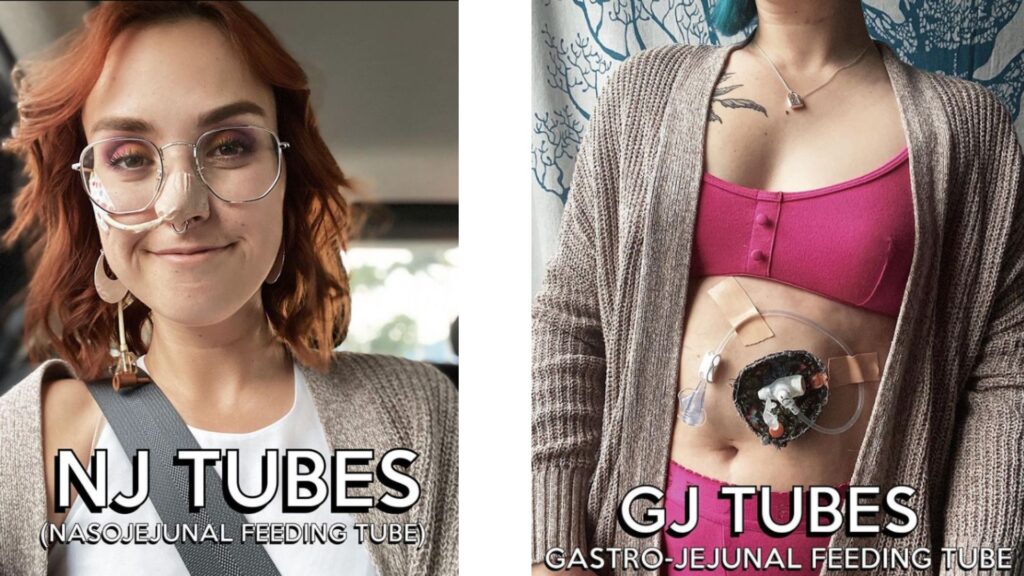If you’ve recently been told that you need a feeding tube, you likely have many emotions and questions. Know that you are not alone and, while this new chapter may feel scary, feeding tubes can be incredible tools for getting your body the nutrients it needs to heal! There are many reasons why someone would need alternative nutrition, and so there are many types of feeding tubes to meet different needs. Learning a bit about each type can help you go into your next appointment feeling prepared.
For other questions, support, and gear, check out our Feeding Tube Resource Guide and the best backpack for tube-fed patients.
What do the different names/acronyms mean?
Here’s a little dictionary to get you started:
To describe how the tube is inserted –
- naso – inserted through the nostril
- oro – inserted through the mouth
- percutaneous – inserted through the skin (on the abdomen)
- endoscopic – placed using an endoscope (camera inserted in the esophagus)
- stoma – a hole in the abdomen is created to insert feeding tubes
Naso/oro tubes do not require surgery but can cause tissue breakdown if left in longer than 4-6 weeks. They are therefore often used for shorter-term needs. Percutaneous tubes require surgery for placement but can stay in long term.
To describe where the tube empties into –
- gastric – into the stomach
- enteric – into the intestines
- duodenal – into the first part of the small intestine
- jejunal – into the second, larger part of the small intestine
Different types of tubes are described by matching up these terms to show how they are inserted and where they empty. For example, a nasogastric (NG) tube would enter through the nose and empty into the stomach. A percutaneous endoscopic jejunal (PEJ) tube would enter through a stoma in the abdomen and empty into the small intestine. This process would be guided by an endoscopy camera.

What do these different types of feeding tubes look like?
Nasojejunal (NJ) tubes are soft and flexible tubes inserted through the patient’s nostril. The tube ends in the jejunum, part of the small intestines.
These tubes are commonly prescribed for short-term use and treatment of malnutrition. However, many patients will undergo a trial period of tube feeding with a nasal tube to see if their body tolerates enteral feeding before undergoing a surgical feeding tube placement procedure.
Both medications and formula can be administered through the feeding tube to make sure patients receive optimal nutrition and medication absorption.
Gastro-jejunal (GJ) tubes (also called percutaneous endoscopic gastro-jejunal, or PEG-J) are surgically-placed feeding tubes that enter the stomach through the abdominal wall and reach down to the jejunum for enteral feeding and medication administration.
These tubes access both the stomach and the jejunum. This allows the patients to vent or drain their stomach when nauseated, release built-up air from swallowing, etc.
There are two types of GJ tubes. There are danglers, where the tubing comes out of the abdomen with a y-shaped port for access. These tubes are used for initial placement but are also more readily covered by insurance.
Low-profile or button tubes, such as the Mic-Key GJ tube pictured above, are placed after the initial healing process. These low-profile tubes allow the patient more freedom and only have the tubing attached when feeding/venting/draining.
Embarking on the journey of incorporating a feeding tube into your life may initially be overwhelming, but remember, you are not alone. Now that you’ve learned everything you need to know about the different kinds of tubes, explore our helpful guide to enteral feeding pumps. To make this journey more manageable and comfortable, check out our innovative Fluid Motion Backpack for reliable, secure, and mobile storage for enteral feeding systems and supplies. Got more questions? Reach out any time at [email protected] (P.S. We read every single email).


One Response